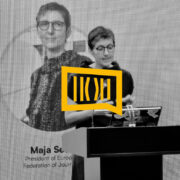
Whether technical-technological changes lead us to a better society is a key question that should be asked when considering changes in media platforms, stressed one of the lecturers at the School of Digital Trade Unionism, Dragana Zaric.
She started the lecture “Old and New Journalism” with questions – what is journalism today, what has changed, and what is the future of the profession.
Zaric pointed out that, although the forms, ways of expression, genres have changed, principles should remain the same. The fact that we use new technology, she added, does not mean that we should give up the truth, research, honest reporting.
“The difference between ‘old’ and ‘new’ journalism sometimes seems like the difference between silence and noise. Silence allows insight into the depths. The noise is superficial and shallow. However, we do not have to use new media as consumables. We can slow down and use silence for good ideas. We need resistance to the dominance of noise “, said Zaric.
She reminded that the beginning of this millennium is marked as a turning point in the history of media and journalism, when the Internet and new communication platforms are rapidly developing.
Zaric pointed to two views on the future of journalism – optimistic and pessimistic.
“Optimists point out the two-way communication and greater participation of citizens in the placement of information, while pessimists point to the negative impact of digitalization on interpersonal and intrapersonal communication,” said Zaric.
Speaking about historically significant events for the development of the media, the lecturer said that it was not news that technological development intensified doubts and questions – whether to stop and whether we really need a new product.
The students of the School of Digital Trade Unionism were interested in how the development of artificial intelligence and robotics will affect journalists, so a discussion on the future of the profession was opened.
“A robot was produced in China that reads the news in a daily news program. Shortly afterwards, experts asked the question – is the death of journalism approaching “, reminded Zaric.
She pointed out that, along with accepting technological changes, we should think about ethics, that is, respond to new challenges with ethical principles.
Zaric also spoke about the convergence of the media, changes within the classic journalistic genres, and presented characteristic examples from domestic and foreign media that illustrate the changes in reporting.
In the end, she referred to the so-called “slow” movement that argues that global society needs to slow down the pace of life. Part of that movement is the idea of ”slow” journalism.
“It is an idea that advocates the need for slower production and use of information. The so-called ‘Slow-moving’ topics are given primacy. Slower here means deeper, more analytical, more comprehensive. Public services can afford the implementation of this idea the most, because they do not depend exclusively on marketing and commercial activities “, concluded Zaric.
The school of digital unionism is organized within the “Union to Union 2021” project, supported by the International Federation of Journalists.









